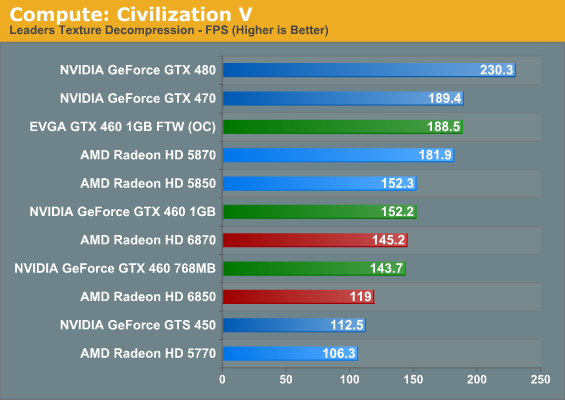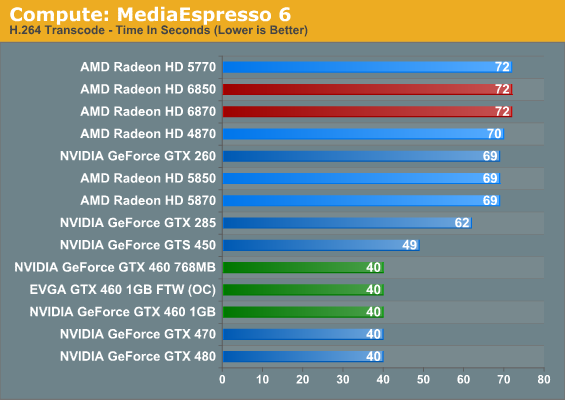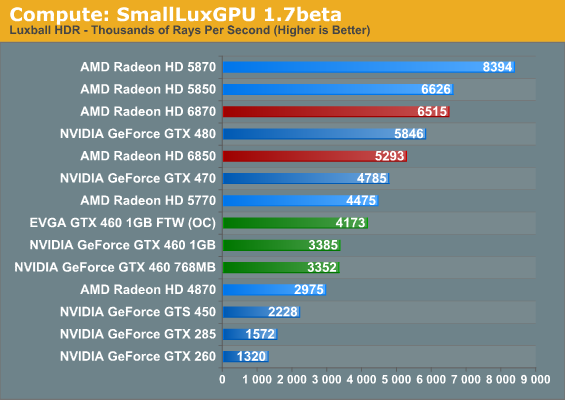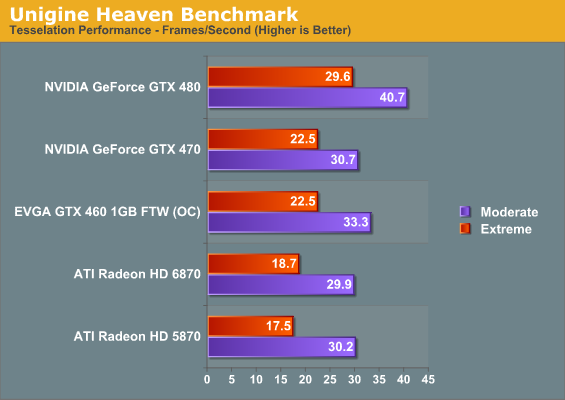AMD’s Radeon HD 6870 & 6850: Renewing Competition in the Mid-Range Market
by Ryan Smith on October 21, 2010 10:08 PM ESTFor a while now we’ve been trying to establish a proper cross-platform compute benchmark suite to add to our GPU articles. It’s not been entirely successful.
While GPUs have been compute capable in some form since 2006 with the launch of G80, and AMD significantly improved their compute capabilities in 2009 with Cypress, the software has been slow to catch on. From gatherings such as NVIDIA’s GTC we’ve seen first-hand how GPU computing is being used in the high-performance computing market, but the consumer side hasn’t materialized as quickly as the right situations for using GPU computing aren’t as straightforward and many developers are unwilling to attach themselves to a single platform in the process.
2009 saw the ratification of OpenCL 1.0 and the launch of DirectCompute, and while the launch of these cross-platform APIs removed some of the roadblocks, we heard as recently as last month from Adobe and others that there’s still work to be done before companies can confidently deploy GPU compute accelerated software. The immaturity of OpenCL drivers was cited as one cause, however there’s also the fact that a lot of computers simply don’t have a suitable compute-capable GPU – it’s Intel that’s the world’s biggest GPU vendor after all.
So here in the fall of 2010 our search for a wide variety of GPU compute applications hasn’t panned out quite like we expected it too. Widespread adoption of GPU computing in consumer applications is still around the corner, so for the time being we have to get creative.
With that in mind we’ve gone ahead and cooked up a new GPU compute benchmark suite based on the software available to us. On the consumer side we have the latest version of Cyberlink’s MediaEspresso video encoding suite and an interesting sub-benchmark from Civilization V. On the professional side we have SmallLuxGPU, an OpenCL based ray tracer. We don’t expect this to be the be all and end all of GPU computing benchmarks, but it gives us a place to start and allows us to cover both cross-platform APIs and NVIDIA & AMD’s platform-specific APIs.
Our first compute benchmark comes from Civilization V, which uses DirectCompute to decompress textures on the fly. Civ V includes a sub-benchmark that exclusively tests the speed of their texture decompression algorithm by repeatedly decompressing the textures required for one of the game’s leader scenes.

In our look at Civ V’s performance as a game, we noted that it favors NVIDIA’s GPUs at the moment, and this may be part of the reason why. NVIDIA’s GPUs clean up here, particularly when compared to the 6800 series and its reduced shader count. Furthermore within the GPU families the results are very straightforward, with the order following the relative compute power of each GPU. To be fair to AMD they made a conscious decision to not chase GPU computing performance with the 6800 series, but as a result it fares poorly here.
Our second compute benchmark is Cyberlink’s MediaEspresso 6, the latest version of their GPU-accelerated video encoding suite. MediaEspresso 6 doesn’t currently utilize a common API, and instead has codepaths for both AMD’s APP (née Stream) and NVIDIA’s CUDA APIs, which gives us a chance to test each API with a common program bridging them. As we’ll see this doesn’t necessarily mean that MediaEspresso behaves similarly on both AMD and NVIDIA GPUs, but for MediaEspresso users it is what it is.

We decided to go ahead and use MediaEspresso in this article not knowing what we’d find, and it turns out the results were both more and less than we were expecting at the same time. While our charts don’t show it, video transcoding isn’t all that GPU intensive with MediaEspresso; once we achieve a certain threshold of compute performance on a GPU – such as a GTX 460 in the case of an NVIDIA card – the rest of the process is CPU bottlenecked. As a result all of our Fermi NVIDIA cards at the GTX 460 or better take just as long to encode our sample video, and while the AMD cards show some stratification, it’s on the order of only a couple of seconds. From this it’s clear that with Cyberlink’s technology having a GPU is going to help, but it can’t completely offload what’s historically been a CPU-intensive activity.
As for an AMD/NVIDIA cross comparison, the results are straightforward but not particularly enlightening. It turns out that MediaEspresso 6 is significantly faster on NVIDIA GPUs than it is on AMD GPUs, but since we’ve already established that MediaEspresso 6 is CPU limited when using these powerful GPUs, it doesn’t say anything about the hardware. AMD and NVIDIA both provide common GPU video encoding frameworks for their products that Cyberlink taps in to, and it’s here where we believe the difference lies.
In particular we see MediaEspresso 6 achieve 50% CPU utilization (4 core) when being used with an NVIDIA GPU, while it only achieves 13% CPU utilization (1 core) with an AMD GPU. At this point it would appear that the CPU portions of NVIDIA’s GPU encoding framework are multithreaded while AMD’s framework is singlethreaded. And since the performance bottleneck for video encoding still lies with the CPU, this would be why the NVIDIA GPUs do so much better than the AMD GPUs in this benchmark.
Our final GPU compute benchmark is SmallLuxGPU, the GPU ray tracing branch of the open source LuxRender renderer. While it’s still in beta, SmallLuxGPU recently hit a milestone by implementing a complete ray tracing engine in OpenCL, allowing them to fully offload the process to the GPU. It’s this ray tracing engine we’re testing.

Compared to our other two GPU computing benchmarks, SmallLuxGPU follows the theoretical performance of our GPUs much more closely. As a result our Radeon GPUs with their difficult-to-utilize VLIW5 design end up topping the charts by a significant margin, while the fastest comparable NVIDIA GPU is still 10% slower than the 6850. Ultimately what we’re looking at is what amounts to the best-case scenarios for these GPUs, with this being as good an example as any that in the right circumstances AMD’s VLIW5 shader design can go toe-to-toe with NVIDIA’s compute-focused design and still win.
At the other end of the spectrum from GPU computing performance is GPU tessellation performance, used exclusively for graphical purposes. For the Radeon 6800 series, AMD enhanced their tessellation unit to offer better tessellation performance at lower tessellation factors. In order to analyze the performance of AMD’s enhanced tessellator, we’re using the Unigine Heaven benchmark and Microsoft’s DirectX 11 Detail Tessellation sample program to measure the tessellation performance of a few of our cards.

Since Heaven is a synthetic benchmark at the moment (the DX11 engine isn’t currently used in any games) we’re less concerned with performance relative to NVIDIA’s cards and more concerned with performance relative to the 5870. Compared to the 5870 the 6870 ends up being slightly slower when using moderate amounts of tessellation, while it pulls ahead when using extreme amounts of tessellation. Considering that the 6870 is around 7% slower in games than the 5870 this is actually quite an accomplishment for Barts, and one that we can easily trace back to AMD’s tessellator improvements.

Our second tessellation test is Microsoft’s DirectX 11 Detail Tessellation sample program, which is a much more straightforward test of tessellation performance. Here we’re simply looking at the framerate of the program at different tessellation levels, specifically level 7 (the default level) and level 11 (the maximum level). Here AMD’s tessellation improvements become even more apparent, with the 6870 handily beating the 5870. In fact our results are very close to AMD’s own internal results – at level 7 the 6870 is 43% faster than the 5870, while at level 11 that improvement drops to 29% as the increased level leads to an increasingly large tessellation factor. However this also highlights the fact that AMD’s tessellation performance still collapses at high factors compared to NVIDIA’s GPUs, making it all the more important for AMD to encourage developers to use more reasonable tessellation factors.










197 Comments
View All Comments
krumme - Friday, October 22, 2010 - link
No it more looks like NV have been playing around with rivatuner.Their cards at stock speed is a toaster. Overclocking again just before an AMD release does not make it better.
If they can sell cards at higher speeds do it. Release it. Dont talk about it, or coverdly hide behind factory overclocked cards. Pathetic and weak.
The sad thing about it is they made Anand change their methology.
What a sad result when the start was just bad gfx cards.
MrSpadge - Friday, October 22, 2010 - link
Not sure it was mentioned before: Cypress and RV770 run FP64 at 2/5th the FP32 speed, not 1/5th as written on the first page.MrS
Quantumboredom - Friday, October 22, 2010 - link
It's 2/5 for addition, but 1/5 for multiplication and FMA as I recall it.krumme - Friday, October 22, 2010 - link
I you want real world testning for solid buying knowledge and no idiotic mixing of oc and non oc cards go to HardocpAnand needs to do a solid review of his own gfx reviews. This is stoneage methology with a fishy smell.
For the ssd there was an excellent revision with the real world bm suite introduction, - a revision far deeper is needed here.
chillmelt - Friday, October 22, 2010 - link
I agree. Comparing a non-OC'd card to an OC'd one is in no way fair. The 6870 clearly clubbered 460 gtx in virtually all benchmarks, at stock speeds.krumme - Friday, October 22, 2010 - link
Yes. Think about this scenario: For this review anand (kyle) decided to use an overclocked Sapphire 6870 and compare it to a stock speed 460.What would happen? How would that look?
Its the same thing happening here.
mindbomb - Friday, October 22, 2010 - link
if they are in the same price range, they should be compared.it gives the consumer more information on his purchasing decision.
idk why this arbitrary oc/non-oc rule comes into play. It was a factory overclock, and required nothing on the part of the end user.
krumme - Friday, October 22, 2010 - link
Okey. Now take an OC 6850, 900Mhz, and compare it to a far more expensive stock 460 1G?Where does this end. AMD and NV suplying the sites with factory overclocked cards for reviews. Its going to be a f..king mess. No one knows about availability, time period and so on.
Regarding pruchasing decision all the methology is plain wrong. Go to Hardocp if you consider buying a card. Here you have real world testing. Not like this old bad - and now fishy - methology of anand.
Why does he change methology just when he is getting the new cards. Hmm. Thats simply very bad science.
NV should concentrate on making cards that performs instead of using ressources putting pressure on sites like anand. If they have faster 460 models release it, or stop spinning.
Its a pain to read and watch. And its a shame for a site, that have the ressources to do proper testing, but dont have the balls any more.
We dont like AMD, Intel nor NV to influence the reviews. Right now there is an obvious bad influence from especially NV. And you, and everyone can see it. Dont underestimate the consequenses.
bji - Friday, October 22, 2010 - link
You COMPLETELY missed the point. *IF* the OC 6850 was a factory overclocked card, sold at a price that puts it in the range of cards reviewed, then it *WOULD* make sense to compare it.So your example just further makes the point.
krumme - Friday, October 22, 2010 - link
Well as it stands now they dont release oc cards at launch day, but that will soon change..., if Anand and others dont stick to their policy